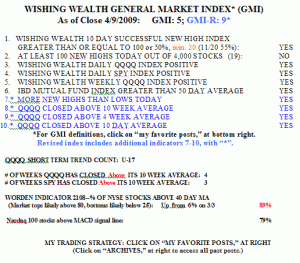I just completed the best 2 week period in a year. I own a lot of the stocks listed to the right, which are having terrific runs. The GMI registered 5 for the first time since August, 2008, before the start of the major market decline. My Successful 10 day New High Index turned positive. There were finally enough stocks that hit a new high 10 days ago that have closed higher than they did 10 days ago.
Stocks on the 52 week new high lists that are also at or near all time highs is where I find potential rockets. Nicolas Darvas made a fortune trading such stocks. IBD100 stocks near all time highs include: GMCR, NFLX, MNRO, QSII, VLGEA, AZO, SNDA, NTES, ALGT. TNDM. TSYS, HGG and ORLY are also very strong, but are not yet on my IBD100 lists.
While most of the world looks for bargain stocks at new lows, I seek rockets heading to the moon. The greatest winning stocks are those heading up to ever higher levels. Think of how many times that YHOO or CSCO or MSFT hit all time new highs as they multiplied their prices many times during their great bull runs. If you want to hop a rocket to the moon, it better be pointing up and gaining altitude.
So, the GMI is very strong.  The final indicator that needs to turn positive requires 100 daily new highs. We had 19 last Thursday. The major cautious signal I see is that the Worden T2108 indicator is so high, at 89%. However, this indicator can remain high for a long time. It is only at the other extreme (oversold, below 20%) that it tends to snap back quickly like a stretched rubber band. Meanwhile, the QQQQ and SPY have closed above their 10 week averages for several weeks. It is during such times that I have found that buying rockets pays off.
The final indicator that needs to turn positive requires 100 daily new highs. We had 19 last Thursday. The major cautious signal I see is that the Worden T2108 indicator is so high, at 89%. However, this indicator can remain high for a long time. It is only at the other extreme (oversold, below 20%) that it tends to snap back quickly like a stretched rubber band. Meanwhile, the QQQQ and SPY have closed above their 10 week averages for several weeks. It is during such times that I have found that buying rockets pays off.
Meanwhile, I am not yet ready to put my university pension funds back into the market. I want to see more strength in the longer term moving averages first. When I go back in, I will dollar cost average in, in phases. I might re-invest one quarter of my cash every few months. When you get out near the top, before a large decline, you can take your time wading back in.
Your rules for the first entry of the GMI index has evidently changed since the definition posted in April 2005. Would you provide readers with the current rules for a yes rating on this indicator or tell us where we can find it?
Thanks